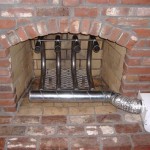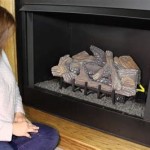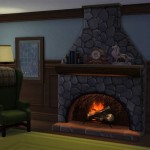Understanding Propane Fireplace Burners: A Comprehensive Guide
Propane fireplaces offer a convenient and efficient alternative to traditional wood-burning fireplaces, providing warmth and ambiance with the simple turn of a knob. At the heart of this system lies the propane fireplace burner, a critical component responsible for converting propane gas into a controlled and visually appealing flame. This article delves into the intricacies of propane fireplace burners, exploring their types, functionalities, maintenance requirements, and troubleshooting tips.
The primary function of a propane fireplace burner is to distribute propane gas in a controlled manner, allowing it to mix with oxygen and ignite, creating a sustained and realistic flame. The burner's design directly influences the flame pattern, heat output, and overall aesthetic appeal of the fireplace. Choosing the right burner type and ensuring its proper maintenance are crucial for achieving optimal performance and safety.
Propane fireplaces offer several advantages, including ease of use, consistent heat output, and reduced maintenance compared to wood-burning fireplaces. They eliminate the need for firewood storage and ash removal, making them a convenient option for many homeowners. Furthermore, propane fireplaces can be installed in a variety of locations, as they do not require a chimney. However, they rely on a consistent supply of propane gas, either from a direct line or a propane tank, and proper ventilation is essential to prevent the buildup of carbon monoxide.
Types of Propane Fireplace Burners
Propane fireplace burners come in a variety of designs, each offering unique flame patterns and aesthetic characteristics. Understanding the different types available is essential for selecting the most suitable burner for a particular fireplace and desired ambiance. The burner type also affects the installation procedure and maintenance requirements.
One common type is the
pipe burner
, which consists of a simple metal pipe with small holes or slots drilled along its length. Propane gas flows through the pipe and exits through these openings, creating a linear flame pattern. Pipe burners are known for their simplicity and durability, making them a reliable option for many fireplaces. The flame height and intensity can be adjusted by controlling the gas flow rate.Another popular type is the
ribbon burner
, which features a long, narrow ribbon of metal with a series of closely spaced slits or perforations. Propane gas flows through the ribbon and ignites along its surface, creating a continuous, ribbon-like flame. Ribbon burners offer a more uniform and visually appealing flame pattern compared to pipe burners, and they are often used in contemporary fireplace designs. They are often more prone to clogging, requiring more frequent maintenance than pipe burners.Cast iron burners
are known for their durability and ability to retain heat. These burners are typically molded into intricate shapes and designs, adding to the aesthetic appeal of the fireplace. Cast iron burners can distribute heat more evenly compared to other types, creating a more comfortable and consistent warmth. However, they can be heavier and more expensive than other burner options.Ceramic burners
utilize a porous ceramic material to distribute propane gas. The gas seeps through the ceramic and ignites on the surface, creating a realistic and flickering flame. Ceramic burners are known for their efficiency and ability to produce a natural-looking flame. They can be more fragile than metal burners and may require more careful handling.Multi-burner systems
incorporate several individual burners grouped together to create a larger and more impressive flame display. These systems often utilize a combination of different burner types to achieve a specific flame pattern and heat output. Multi-burner systems are commonly found in larger fireplaces and commercial settings.The selection of a specific burner type often depends on the desired aesthetic, the size of the fireplace, and the budget. Each type offers unique advantages and disadvantages, and careful consideration should be given to these factors before making a decision.
Functionality and Components of a Propane Fireplace Burner System
A propane fireplace burner system consists of several interconnected components that work together to ensure safe and efficient operation. Understanding the function of each component is essential for proper maintenance and troubleshooting.
The
gas valve
controls the flow of propane gas to the burner. It is typically equipped with a safety shutoff mechanism that automatically cuts off the gas supply in the event of a flame failure. The gas valve is a crucial safety component and should be inspected regularly for leaks or malfunctions.The
thermocouple or thermopile
is a safety device that generates a small electrical current when heated by the pilot light or main burner flame. This current keeps the gas valve open, allowing propane gas to flow to the burner. If the pilot light or main burner flame goes out, the thermocouple or thermopile cools down, interrupting the electrical current and causing the gas valve to close, preventing gas leakage. A faulty thermocouple or thermopile is a common cause of fireplace malfunction.The
igniter
is responsible for initiating the combustion process. It can be either a manual spark igniter or an electronic igniter. Manual spark igniters use a piezoelectric crystal to generate a spark when a button is pressed. Electronic igniters use a battery-powered circuit to create a spark. A malfunctioning igniter will prevent the fireplace from lighting.The
pilot light
is a small flame that continuously burns and ignites the main burner when the gas valve is opened. The pilot light ensures that the fireplace can be easily lit and provides a constant source of ignition. A dirty or clogged pilot light can cause ignition problems.The
burner ports
or orifices are small openings in the burner that allow propane gas to escape and mix with oxygen. The size and spacing of these ports determine the flame pattern and heat output. Clogged or obstructed burner ports can lead to uneven flames or reduced heat output.The
air shutter
regulates the amount of air that mixes with propane gas before combustion. Adjusting the air shutter can optimize the flame quality and prevent sooting. Improper air-to-fuel mixture can result in inefficient combustion and the production of carbon monoxide.The
log set
is a decorative element that enhances the aesthetic appeal of the fireplace. The log set is typically made of ceramic or refractory materials and is designed to resemble real wood logs. The log set should be positioned correctly to ensure proper airflow around the burner.Maintenance and Troubleshooting of Propane Fireplace Burners
Regular maintenance is essential for ensuring the safe and efficient operation of a propane fireplace burner. Neglecting maintenance can lead to performance issues, safety hazards, and costly repairs. A qualified technician should perform major repairs or maintenance, but some basic tasks can be performed by homeowners.
Cleaning the burner:
Over time, dust, debris, and soot can accumulate on the burner, clogging the ports and affecting the flame quality. The burner should be cleaned periodically using a soft brush or vacuum cleaner. Avoid using harsh chemicals or abrasive cleaners, as these can damage the burner surface.Inspecting the pilot light:
The pilot light should be inspected regularly to ensure that it is burning with a strong, blue flame. A weak or yellow flame indicates a dirty or clogged pilot light. The pilot light assembly can be cleaned with a small brush or a specialized pilot light cleaning tool.Checking the gas valve:
The gas valve should be inspected for leaks or malfunctions. A gas leak can be detected by applying a soapy water solution to the gas valve connections and looking for bubbles. If a gas leak is suspected, the gas supply should be shut off immediately, and a qualified technician should be contacted.Inspecting the thermocouple or thermopile:
The thermocouple or thermopile should be inspected for damage or corrosion. If the thermocouple or thermopile is not generating sufficient electrical current, it may need to be replaced. A multimeter can be used to test the output of the thermocouple or thermopile.Adjusting the air shutter:
The air shutter should be adjusted to optimize the flame quality. If the flames are yellow or sooty, the air shutter should be opened slightly to allow more air to mix with the propane gas. If the flames are blue and flickering, the air shutter should be closed slightly to reduce the amount of air. The optimal air shutter setting will vary depending on the fireplace and the propane gas pressure.Troubleshooting common problems:
Common problems with propane fireplace burners include ignition problems, weak flames, uneven flames, and gas leaks. Ignition problems can be caused by a faulty igniter, a dirty pilot light, or a malfunctioning thermocouple or thermopile. Weak flames can be caused by clogged burner ports, low gas pressure, or a restricted air supply. Uneven flames can be caused by uneven gas distribution or clogged burner ports. Gas leaks should be addressed immediately by shutting off the gas supply and contacting a qualified technician.Preventative maintenance can significantly extend the lifespan of a propane fireplace burner and ensure its safe and efficient operation. By performing regular inspections and cleaning, homeowners can identify and address potential problems before they escalate into major repairs.

All About Gas Burners For Fireplaces Types Features

Rectangle Square Round 304 Stainless Steel Propane Gas Indoor Outdoor Fireplace Burner Kit China Fire Pit Made In Com

Rectangle Square Round 304 Stainless Steel Propane Gas Indoor Outdoor Fireplace Burner Kit China Fire Pit Made In Com

Ashley Hearth S 1500 Sq Ft Burner Vent Free Freestanding Liquid Propane Gas Stove In The Stoves Department At Com

Lakefield Xl Direct Vent Freestanding Gas Fireplace Stove Kozy Heat

Kingsman Fp2785lpt Fl 27 Inch Rectangular Push On Spark Ignition Propane Fire Pit Burner Kit

Comparing Wood And Propane Heat Tiny Stove

Napoleon Gds50 The Fireplace King Huntsville Ontario Muskoka For Your Heating Cooling And Grilling Needs

Stowe On Demand Pilot Hearthstone Stoves

Enviro G Series Glass Burner Traditional Gas Or Propane Fireplace Fireplaces By Cameron
Related Posts








